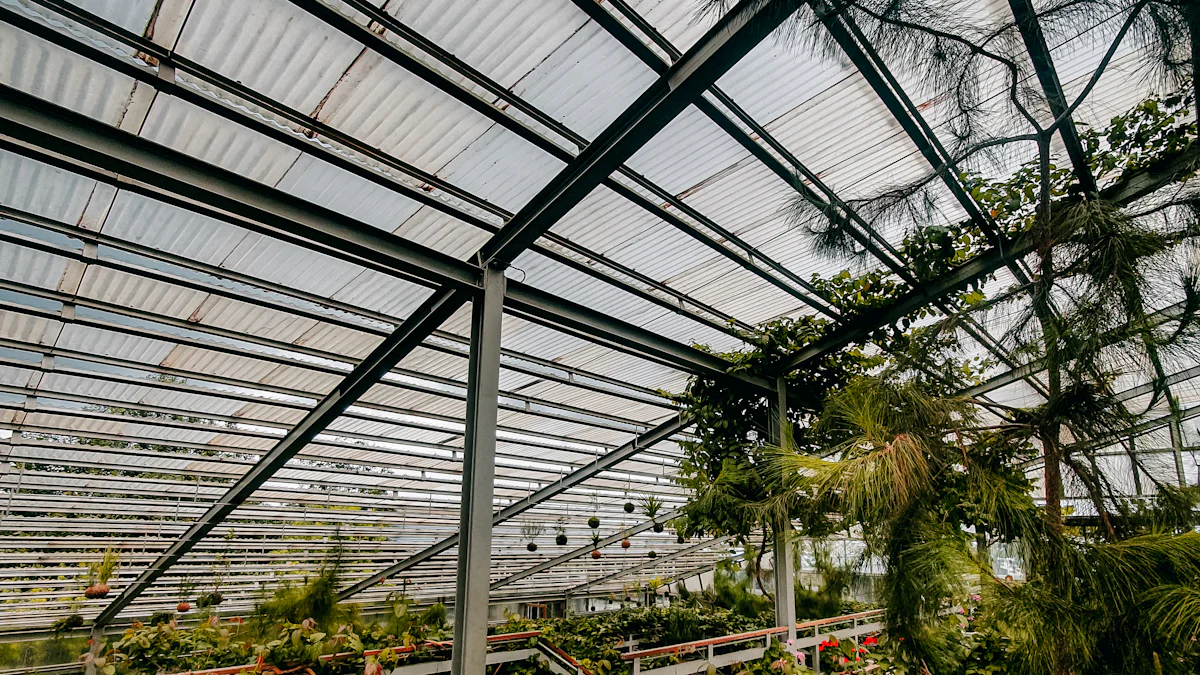
Image Source: pexels
Polycarbonate roofing panels offer a compelling choice for your roofing needs. You will find them durable, lightweight, and equipped with UV protection. These panels stand out due to their remarkable strength and low maintenance requirements. They can withstand extreme weather conditions, making them virtually unbreakable. Their popularity in modern roofing solutions continues to rise. The market for these panels is projected to grow significantly, driven by increased urbanization and construction sector growth. With a lifespan ranging from 10 to 25 years, they provide a long-lasting solution for both residential and commercial buildings.
Benefits of Polycarbonate Roofing Panels
 Image Source: unsplash
Image Source: unsplash
Durability and Strength
Polycarbonate roofing panels offer exceptional durability and strength, making them a reliable choice for your roofing needs.
Resistance to Impact and Weather Conditions
You will find that polycarbonate roofing panels excel in resisting impact and harsh weather conditions. Unlike traditional materials like metal or asphalt, these panels withstand severe weather effectively. Their high impact resistance makes them virtually unbreakable, even in extreme conditions. This resilience ensures that your roof remains intact during storms or hail, providing peace of mind.
Longevity Compared to Traditional Materials
When you choose polycarbonate roofing panels, you invest in a long-lasting solution. These panels outlast many traditional materials, such as metal roofing panels. With a lifespan ranging from 10 to 25 years, they offer a durable option for both residential and commercial buildings. Their longevity reduces the need for frequent replacements, saving you time and money in the long run.
Lightweight Nature
The lightweight nature of polycarbonate roofing panels provides several advantages for your roofing projects.
Ease of Handling and Installation
Handling and installing polycarbonate roofing panels is straightforward due to their lightweight design. You can easily transport and position them without requiring heavy machinery or extensive labor. This ease of installation not only saves time but also reduces labor costs, making them an economical choice for your roofing needs.
Reduced Structural Load
Polycarbonate roofing panels place less stress on your building’s structure. Their lightweight nature means they exert less load compared to heavier materials like glass or metal. This reduced structural load can be particularly beneficial for older buildings or structures with limited load-bearing capacity, ensuring safety and stability.
UV Protection and Insulation
Polycarbonate roofing panels provide excellent UV protection and insulation, enhancing the comfort and efficiency of your space.
Protection from Harmful UV Rays
These panels come equipped with built-in UV protection, shielding you from harmful ultraviolet rays. This feature not only protects your skin but also prevents fading and damage to interior furnishings. By blocking UV rays, polycarbonate roofing panels help maintain the integrity and appearance of your indoor spaces.
Energy Efficiency and Temperature Regulation
Polycarbonate roofing panels contribute to energy efficiency by regulating temperature. They offer better light transmission properties compared to materials like PVC roofing, allowing natural light to illuminate your space while minimizing heat gain. This balance of light and insulation reduces the need for artificial lighting and air conditioning, leading to lower energy bills.
Aesthetic Appeal
Polycarbonate roofing panels not only offer practical benefits but also enhance the visual appeal of your building. Their aesthetic versatility makes them a popular choice for modern architecture.
Variety of Colors and Finishes
You can choose from a wide range of colors and finishes when selecting polycarbonate roofing panels. This variety allows you to match the panels with your building’s existing color scheme or create a striking contrast. Whether you prefer a subtle, transparent look or a bold, vibrant hue, polycarbonate panels provide options to suit your taste. The finishes available range from glossy to matte, adding another layer of customization to your roofing project.
Modern and Sleek Design Options
Polycarbonate panels contribute to a sleek and modern design aesthetic. Their smooth surface and clean lines complement contemporary architectural styles. Unlike traditional materials like metal or asphalt, polycarbonate panels offer a more refined appearance. They allow for creative design possibilities, such as curved or angled installations, which can transform the look of your space. By choosing polycarbonate roofing, you can achieve a stylish and sophisticated finish that enhances the overall appeal of your property.
Types of Polycarbonate Panels
 Image Source: unsplash
Image Source: unsplash
When selecting polycarbonate roofing panels, understanding the different types available can help you make an informed decision. Each type offers unique features and benefits, catering to various needs and preferences.
Solid Polycarbonate Panels
Characteristics and Common Uses
Solid polycarbonate panels are known for their robust and clear appearance. You will find them ideal for applications requiring high impact resistance and transparency. These panels are often used in areas like skylights, greenhouses, and safety glazing. Their clarity allows maximum light transmission, making them suitable for spaces where natural light is essential.
Pros and Cons
Pros:
- High impact resistance
- Excellent light transmission
- UV protection
Cons:
- Higher cost compared to other types
- Less insulation compared to multiwall panels
Multiwall Polycarbonate Panels
Insulation Properties and Applications
Multiwall polycarbonate panels consist of multiple layers, creating air pockets that enhance insulation. You will appreciate their ability to regulate temperature, making them perfect for greenhouses and conservatories. These panels provide a balance between light transmission and thermal insulation, ensuring energy efficiency.
Pros and Cons
Pros:
- Superior insulation properties
- Lightweight and easy to handle
- Cost-effective
Cons:
- Reduced light transmission compared to solid panels
- May require additional support for larger spans
Corrugated Polycarbonate Panels
Flexibility and Versatility
Corrugated polycarbonate panels offer flexibility and versatility, making them a popular choice for various roofing projects. You can use them for carports, pergolas, and industrial buildings. Their corrugated design provides strength and allows for easy installation on curved surfaces.
Pros and Cons
Pros:
- Self-supporting structure
- Easy installation
- Cost-effective
Cons:
- Limited color options
- Less aesthetic appeal compared to solid panels
The combination of durability, design flexibility, energy efficiency, and safety makes polycarbonate roofing a highly attractive option for modern construction.
Choosing the right type of polycarbonate roofing panels depends on your specific needs and the intended application. Whether you prioritize insulation, light transmission, or structural flexibility, polycarbonate panels offer a solution that blends functionality with aesthetics.
Factors to Consider When Choosing
Climate Suitability
When selecting polycarbonate roofing panels, you should consider the climate in your area. These panels excel in various weather conditions due to their durability and resistance to extreme temperatures. However, they can become brittle and yellow when exposed to prolonged UV light. If you live in a region with intense sunlight, ensure that the panels have adequate UV protection to maintain their appearance and functionality over time.
Weather Resistance and Adaptability
Polycarbonate panels are renowned for their ability to withstand harsh weather. They resist impact and do not crack easily, making them suitable for areas prone to storms or hail. Their adaptability to different climates ensures that your roof remains intact and functional, providing reliable protection for your home or building.
Panel Thickness
The thickness of polycarbonate panels plays a crucial role in their performance. Thicker panels offer better insulation and durability, making them ideal for regions with extreme weather conditions. However, they may also be heavier and more expensive.
Impact on Durability and Insulation
Thicker panels enhance the roof’s durability and provide superior insulation. This feature helps regulate indoor temperatures, reducing energy costs. When choosing panel thickness, balance the need for insulation with the structural capacity of your building to ensure safety and efficiency.
Color Options
Polycarbonate panels come in various colors, each affecting light transmission and aesthetic appeal. The color you choose can influence the amount of natural light entering your space and the overall look of your building.
Aesthetic Considerations and Light Transmission
Consider the visual impact of the panel color on your building’s design. Transparent or lighter colors allow more light to pass through, creating a bright and airy atmosphere. Darker colors may reduce light transmission but offer a sleek and modern appearance. Choose a color that complements your building’s style while meeting your lighting needs.
Budget Constraints
Balancing Cost with Quality and Features
When choosing polycarbonate roofing panels, you need to balance cost with quality and features. These panels offer a range of benefits, including durability, UV protection, and lightweight nature. However, the price can vary based on the type and thickness of the panel.
- Evaluate Your Needs: Determine the specific requirements of your project. If you need high impact resistance and clarity, solid polycarbonate panels might be the best choice. For better insulation, consider multiwall panels. Each type has its own cost implications.
- Consider Long-Term Savings: While polycarbonate panels might have a higher upfront cost compared to traditional materials, they offer long-term savings. Their durability reduces the need for frequent replacements. Additionally, their energy efficiency can lower heating and cooling costs.
- Compare Different Suppliers: Prices can vary between suppliers. Compare quotes from multiple vendors to ensure you get the best deal. Look for suppliers who offer warranties or guarantees, as this can provide added value and peace of mind.
- Assess Installation Costs: Factor in the cost of installation. Polycarbonate panels are lightweight and easy to handle, which can reduce labor costs. However, if your project requires professional installation, get estimates from qualified installers to budget accordingly.
- Prioritize Essential Features: Focus on the features that are most important for your project. If UV protection is crucial, ensure the panels you choose offer this feature. By prioritizing essential features, you can avoid overspending on unnecessary extras.
Polycarbonate panels provide a cost-effective solution when you consider their durability, energy efficiency, and low maintenance requirements. By carefully evaluating your needs and comparing options, you can find a balance between cost and quality that suits your budget.
Installation Tips
Basic Installation Guidelines
Tools and Materials Needed
To install polycarbonate roofing panels, gather the necessary tools and materials. You will need:
- Polycarbonate panels: Choose the type and thickness that suits your project.
- Screws and washers: Use stainless steel or galvanized screws to prevent rust.
- Drill: A power drill with a suitable bit for pre-drilling holes.
- Measuring tape: Ensure accurate measurements for cutting and placement.
- Saw: A fine-toothed saw or circular saw for cutting panels to size.
- Safety gear: Wear gloves and safety goggles to protect yourself during installation.
Step-by-Step Process Overview
- Measure and Cut: Measure the area where you will install the panels. Cut the panels to the required size using a fine-toothed saw. Ensure the cuts are straight and smooth to fit properly.
- Pre-Drill Holes: Pre-drill holes in the panels to prevent cracking. Space the holes evenly along the edges, about 12 inches apart.
- Position Panels: Place the panels on the roof structure. Align them carefully to ensure a neat finish. Overlap the panels slightly to prevent water leakage.
- Secure Panels: Use screws and washers to secure the panels in place. Tighten the screws gently to avoid damaging the panels.
- Seal Joints: Apply a suitable sealant to the joints and overlaps. This step ensures a watertight installation and enhances durability.
Proper installation is crucial for maximizing the lifespan of polycarbonate panels. By following these guidelines, you can ensure a secure and efficient installation.
Hiring a Professional
When to Consider Professional Installation
Consider hiring a professional if your project involves complex designs or large areas. Professionals have the expertise to handle intricate installations and ensure optimal results. If you lack experience or the necessary tools, professional installation can save time and prevent costly mistakes.
Finding a Qualified Installer
To find a qualified installer, follow these steps:
- Research: Look for installers with experience in polycarbonate roofing. Check online reviews and ratings to gauge their reputation.
- Ask for Recommendations: Seek recommendations from friends or family who have used similar services. Personal referrals often lead to reliable professionals.
- Request Quotes: Contact multiple installers to get quotes. Compare their prices and services to find the best fit for your budget and needs.
- Verify Credentials: Ensure the installer has the necessary licenses and insurance. This verification protects you from liability in case of accidents or damages.
Hiring a professional can provide peace of mind and ensure a high-quality installation. By choosing a qualified installer, you can enjoy the benefits of polycarbonate roofing without the hassle of DIY installation.
Maintenance and Longevity
Regular Cleaning and Care
Maintaining your polycarbonate roofing panels involves regular cleaning and care. This ensures they remain in optimal condition and continue to provide the benefits you expect.
Recommended Cleaning Methods
To clean your polycarbonate panels, use a mild soap solution and a soft cloth or sponge. Avoid abrasive materials that might scratch the surface. Rinse thoroughly with water to remove any soap residue. For stubborn dirt or stains, a gentle pressure wash can be effective. Always follow the manufacturer’s guidelines for cleaning to prevent damage.
Frequency of Maintenance
Regular maintenance is key to extending the lifespan of your polycarbonate roofing. Clean the panels at least twice a year, ideally in spring and fall. In areas with heavy pollution or frequent storms, more frequent cleaning might be necessary. Regular inspections help identify any issues early, allowing for timely repairs.
Ensuring Longevity
Ensuring the longevity of your polycarbonate roofing panels involves proactive measures to prevent damage and monitor their condition.
Tips for Preventing Damage
- Avoid Harsh Chemicals: Use only recommended cleaning agents. Harsh chemicals can degrade the UV protective layer.
- Trim Nearby Trees: Overhanging branches can scratch or damage the panels during storms. Regularly trim trees near your roof.
- Inspect for Debris: Remove leaves, twigs, or other debris that may accumulate on the roof. This prevents water pooling and potential damage.
- Check Fastenings: Ensure screws and washers remain tight. Loose fastenings can lead to panel movement and potential leaks.
Monitoring for Wear and Tear
Regularly inspect your polycarbonate panels for signs of wear and tear. Look for discoloration, cracks, or any changes in transparency. These could indicate UV damage or impact stress. Addressing these issues promptly can prevent further damage and extend the life of your roofing.
Polycarbonate roofing panels offer a durable and low-maintenance solution. By following these maintenance tips, you can ensure they remain a valuable investment for years to come.
Polycarbonate roofing panels offer a blend of durability, aesthetics, and functionality. You benefit from their lightweight nature and UV protection, making them a smart choice for modern roofing needs. These panels withstand harsh weather, ensuring long-lasting performance. Industry experts validate their growing popularity, driven by urbanization and construction growth. Explore polycarbonate options to enhance your roofing projects. They provide a cost-effective solution with minimal maintenance. By choosing these panels, you invest in a reliable and visually appealing roofing system that meets diverse needs.
